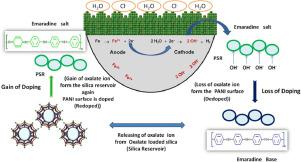Surfaces and Interfaces ( IF 6.2 ) Pub Date : 2021-09-04 , DOI: 10.1016/j.surfin.2021.101440 T. Siva 1, 2 , Ananthakumar Ramadoss 1 , S. Sathiyanarayanan 2

|
The present study reports the mechanism of a silica-based novel self-healing/defect inhibiting coating for the efficient renewal of defects and corrosion on metal substrates, effective from sub-micron to mm dimensions. The coating predominantly employs silica nanoparticles that act as tiny containers evidencing a homogeneous mesoporous surface morphology. The containers were preloaded with the dopant of oxalic acid. After loading the container, aniline monomers were introduced to be preferentially adsorbed on the surface of the silica containers. The aniline on being doped by oxalic acid with electrons joins to form long chains of polyaniline (PANI), covering the entire surface of the silica containers, forming a protective sheet thereby forming sphere-like PANI-SiO2 reservoirs (PSR). The oxalic acid-PANI acts as a charge transfer complex where acid acts as a donor due to the oxalate and an inhibitor at the onset of corrosion, serving the original purpose. Also, Polyaniline (PANI) detects simultaneously and frequently to release the doping ion, and these ions passivate the metal, plus PANI back to the original position getting doping ions from the silica reservoir. The superior corrosion protection of this developed active system compared to traditional epoxy coating was confirmed by electrochemical impedance spectroscopy (EIS) and an imitated corrosion process by the scanning vibrating electrode technique (SVET) in 3% NaCl solution. The observations affirm that the sustained release behavior of the acid dopant is triggered by surface corrosion, revealing self-healing phenomena.
中文翻译:

基于持续自修复涂层的防腐蚀新措施
本研究报告了基于二氧化硅的新型自修复/缺陷抑制涂层的机制,用于有效更新金属基材上的缺陷和腐蚀,从亚微米到毫米尺寸有效。该涂层主要采用二氧化硅纳米粒子作为证明均匀介孔表面形态的微小容器。容器预装有草酸掺杂剂。装入容器后,引入苯胺单体以优先吸附在二氧化硅容器的表面上。苯胺被草酸掺杂电子后连接形成聚苯胺(PANI)长链,覆盖二氧化硅容器的整个表面,形成保护片从而形成球状PANI-SiO 2水库(PSR)。草酸-PANI 充当电荷转移复合物,其中由于草酸盐而酸充当供体,并且在腐蚀开始时充当抑制剂,达到最初的目的。此外,聚苯胺 (PANI) 会同时且频繁地检测以释放掺杂离子,这些离子使金属钝化,加上 PANI 回到原始位置,从二氧化硅储层中获取掺杂离子。电化学阻抗谱 (EIS) 和扫描振动电极技术 (SVET) 在 3% NaCl 溶液中模拟腐蚀过程证实了这种开发的活性系统与传统环氧树脂涂层相比具有优异的腐蚀保护。观察证实酸掺杂剂的缓释行为是由表面腐蚀触发的,揭示了自愈现象。



























 京公网安备 11010802027423号
京公网安备 11010802027423号